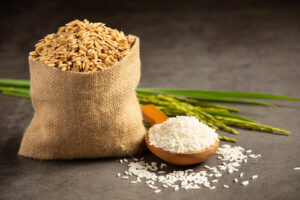Comparing today's diet to that of a century ago, one of the biggest changes is the explosion of low-fiber, high-carb foods. So it's no surprise that low-carb diets are gaining ground.
By significantly limiting carbohydrates, we automatically eliminate a large amount of fast food. However, not all carbohydrates are equally bad or good. Much depends on the biochemical composition of the carbohydrate and also on the so-called "packaging", i.e. how much fiber comes with a particular food.
What is GK and a diet based on it?
What is this GK diet good for?
How does a GK-based diet differ from, for example, the paleo diet?
Principles of GK-based nutrition
Who is carbohydrate restriction not suitable for?
In conclusion
What is GK and a diet based on it?
 The GK diet is an abbreviation for the term glycemic load diet.
The GK diet is an abbreviation for the term glycemic load diet.
It is possible to measure the effect of different carbohydrate-rich foods on blood sugar. For example, we give people a certain amount of a food and measure their blood sugar levels over the next few hours.
This allows you to compare the effects of bread, pasta, cotton candy, and cornflakes on blood sugar levels. This is how the glycemic index of foods is usually calculated. If you also take into account the typical serving size and fiber content, you get the glycemic load of the food.
The higher the glycemic load of a food, the higher our blood sugar levels tend to rise after eating it. Foods with a glycemic load of 10 or less per serving are considered low, and foods with a glycemic load of 20 or more are considered high.
A proper GK diet involves counting and limiting these aforementioned points. Ideally, GK points should be distributed as evenly as possible between meals, and the maximum daily point count is also limited.
An omnivore who wants to lose weight as aggressively as possible is allowed a maximum of 45 points per day. If after a few days you start to feel hungry, you can gradually increase the amount of carbohydrates to 60. A vegetarian could start with 55 points instead of 45 and move up from there if necessary.
What is this GK diet good for?

The GK diet has received a lot of positive feedback in studies.
Lower GI foods help control appetite better. In one study, researchers gave one group a high GI food and another group a low GI food, which otherwise had the same calories, nutrients, and taste.
It turned out that high-GK food activated significantly more of the part of the brain associated with reward and appetite. In addition, this group had a greater appetite four hours later, when it was time for their next meal, than the low-GK group.
What do you think would happen to children who had cornflakes, chocolate chips, or puffed rice for breakfast, compared to children who had a lower glycemic index breakfast, such as oatmeal with a spoonful of sugar?
Just like that an experiment was conducted in one school. If you're asking why sugar was added to the porridge, it was to make the calorie intake of both groups comparable. And even with this added sugar, the porridge eaters ate an average of 100 kcal less at the lunch buffet than those who got crisps for breakfast.
In addition to regulating appetite, they help Foods with lower glycemic index also burn more fatFor example, if you eat a low-GI food (whole grains and fruit) and then go for a walk on a treadmill three hours later, you will burn more calories than someone who previously ate a high-GI food (e.g. cornflakes and white bread).
One reason it's so hard to lose weight is that our bodies protect themselves from fat loss by slowing down their resting metabolism. It turns out that those who lose weight who are on low-GI foods, metabolism slows down significantly lessthan those who eat foods with high GK.
This process also works in reverse. If you eat too much high-GI food, you will store more fat than if you ate the same amount of low-GI food. Those who ate too much low-GK food, 40% still stored less fat.
How is a GK-based diet different from, for example, a paleo or keto diet?
An attentive reader, who is also somewhat familiar with diet trends, will certainly immediately ask how this GK-based approach differs from other common carbohydrate-restricting diets? Or is it more effective for weight loss than a low-fat diet?
To answer these questions, let's take a step back. There are many ways to lose weight. Healthy and not so healthy, fast and slow, by significantly reducing the amount of food energy you consume, by replacing unhealthy foods with healthier ones, or by changing your macronutrient ratios (proteins, fats, carbohydrates).
The GK-based approach does the latter, altering macronutrient ratios. It limits carbohydrates and increases the proportion of fats and proteins. In most cases, the daily calorie intake is also reduced for weight loss purposes.
True, it is not as extreme as the paleo diet, LCHF, keto or ketogenic diet, Atkins, kefir diet, etc., in which the proportion of carbohydrates in daily energy is typically extremely low, staying around 5-10%. In a typical GK diet plan, the proportion of carbohydrates is 40-45%. In other words, the GK-based approach is more moderate and also more nutritionally rich.
 If we eliminate sweets and drinks containing added sugars from our menu, we obviously do not risk losing any important nutrients. The same goes for refined grain products to a certain extent.
If we eliminate sweets and drinks containing added sugars from our menu, we obviously do not risk losing any important nutrients. The same goes for refined grain products to a certain extent.
However, if we start to severely limit whole grain products such as oats, buckwheat, rye, rice, etc. (I'm thinking of these fat and protein-based diets: paleo, LCHF, keto, etc.), then the question immediately arises: where do we get the vitamins and minerals that we are missing out on? In addition, we are also missing out on a large amount of fiber, which is a source of whole grains. And we also have to cover the large deficit in energy that is not eaten in the form of carbohydrates.
As already mentioned, energy is mostly partly covered by fats and proteins, but the source of these fats and proteins is extremely important. By replacing healthy carbohydrates with animal fats and proteins, we are doing our bodies a great disservice.
These extremely fatty and low-carb diets are so successful because they cause weight loss a little faster in the short term than low-fat diets. But there's one important catch. If compare a high-fat and low-fat diet with the same calories, then in terms of overall weight loss, a high-fat diet wins, but you can lose fat faster with a low-fat diet. The catch is that excessive restriction of carbohydrates and eating fat will quickly cause weight loss at the expense of water and muscle. If that's your desire, then go for it. However, I assume that most weight loss patients want to get rid of excess fat while maintaining or even increasing muscle mass.
Principles of a glycemic load-based diet
 Perhaps you've become interested in this GK-based diet and would like to try it yourself? Why not? I'll give you some simple instructions on how to implement a glycemic load-based diet in a moderate and healthy way.
Perhaps you've become interested in this GK-based diet and would like to try it yourself? Why not? I'll give you some simple instructions on how to implement a glycemic load-based diet in a moderate and healthy way.
- The first principle when approaching a GK-based diet is that all products sweetened with added sugar are definitely off the menu. It is also worth being attentive in the store and checking the sugar content of products. For example, the sugar content of breads or pickles can vary freely by 3 times.
- In addition to sweets, all kinds of salty snacks should also be completely avoided.
- Now that junk food is off the menu, you could replace refined grains with whole grains. When choosing a side dish, you could prefer boiled potatoes or white rice to baked potatoes. Or instead of them, take buckwheat with a lower GK, and buckwheat in turn could be preferred to lentils. Namely, legumes are the best friends of a GK-based dieter, being a source of low GK, but high-quality carbohydrates and proteins.
- These healthy, energy-rich carbohydrates should be eaten at every meal, combined with fat and protein. You should eat one carbohydrate source at a meal, and the portion should be no larger than the size of your fist for an omnivore. A vegetarian can increase their portion size slightly, preferably at the expense of legumes.
- Follow the plate rule. At least 50% of the food weight should be minimally processed vegetables, up to 25% of the food should be proteins and fats, and up to 25% of energy-rich carbohydrates. When it comes to proteins and fats, my recommendation is to focus on quality and prefer plant-based sources. For example, legumes, nuts, seeds, avocado, and high-quality olive oil. For a convinced omnivore, it is recommended to prefer fish and poultry over beef, lamb, and pork, and dairy products.
- To ensure that your vitamin and mineral needs are met, you should use various herbs when preparing food whenever possible.
It should be remembered that high-quality carbohydrates should be eaten. Preferably in the form of minimally processed legumes and grains. Especially vegetarians should eat at least 60-90g of legumes every day. Omnivores should also limit their consumption of meat, eggs and dairy products in addition to carbohydrates. Replacing them with fish, legumes and nuts if necessary.
Low-GI vegetables were not mentioned. You should definitely eat more of all kinds of green leafy vegetables and non-starchy vegetables than you are used to. At least 500 g per day, preferably more. In addition, plenty of (not dried) berries and fruits, which can also alleviate your sweet tooth to some extent.
Glycemic load table The GK table helps you calculate and track the amounts and values of nutrients you consume each day. There are also cookbooks based on the GK diet on sale, and GK diet recipes can be found online.
Number of meals and from that, do you eat breakfast and When is it good to eat?, I have already written about it before. In any case, it should be noted that length of overnight fast would be at least 12 hours.
Who is carbohydrate restriction not suitable for?
With all kinds of diets and eating styles, it's important to remember that there is no one eating style that suits absolutely everyone. The same goes for a GK-based diet.
- People with type 1 and type 2 diabetes should avoid low-carb diets because their insulin secretion or glucose uptake mechanisms are impaired. If medications are also used, there is a high risk of hypoglycemia.
- This is not particularly suitable for those suffering from chronic kidney failure. They may instead need to increase the proportion of carbohydrates and reduce protein.
- Older people with a low BMI should be cautious. They may need to increase both their carbohydrate and protein intake.
- Reducing carbohydrates is also not suitable for children. I mean healthy, carbohydrate-rich whole foods, not sweets.
In conclusion
A GK-based diet helps you lose weight, but it is certainly not the only possible or most effective method. If a low-carb diet suits you, then I definitely recommend GK over other, much more extreme diets like the one mentioned above, in addition to the blood type diet. When limiting carbohydrates, you should start with the so-called unhealthy ones and moderately limit the healthy ones (in other words, avoid overeating). At the same time, make sure that everything remains nutritionally balanced. And I definitely recommend consulting a nutritionist before starting any diet.

Allan Randlepp
NutritionistAllan is a nutritionist and trainer whose favorite topics are lifestyle and longevity, including nutrition and physical activity.
Fasting as the best diet?





